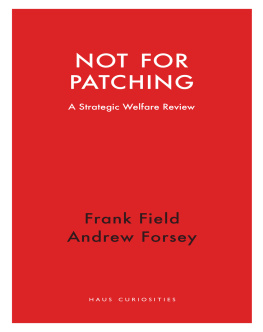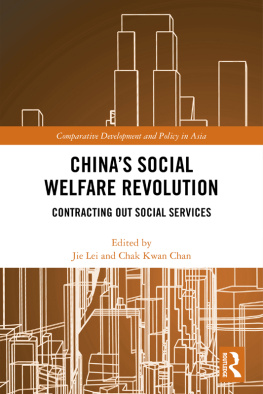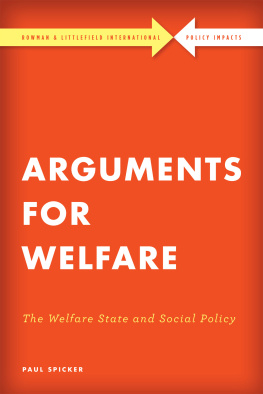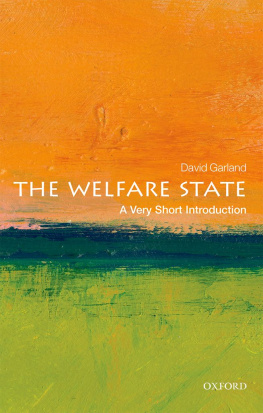Contents
Pagebreaks of the print version
HAUS CURIOSITIES
Not for Patching
About the Contributors
Frank Field has been MP for Birkenhead since 1979. In 199798 he served as the Minister of Welfare Reform and is now Chair of the Work and Pensions Select Committee.
Andrew Forsey is Frank Fields Senior Parliamentary Researcher and served as Secretary to the All-Party Parliamentary Inquiry into Hunger in the United Kingdom.
Frank Field and Andrew Forsey
NOT FOR PATCHING
A Strategic Welfare Review

First published by Haus Publishing in 2018
4 Cinnamon Row
London SW 11 3 TW
www.hauspublishing.com
Copyright Frank Field and Andrew Forsey, 2018
The right of the author to be identified as the author
of this work has been asserted in accordance with
the Copyright, Designs and Patents Act 1988
A CIP catalogue record for this book is
available from the British Library
Print ISBN: 978-1-910376-79-9
Ebook ISBN: 978-1-910376-80-5
Typeset in Garamond by MacGuru Ltd
Printed in Spain
All rights reserved
Preface
A revolutionary moment in the worlds history is a time for revolutions, not for patching
Sir William Beveridge, 1942
A paradox. Elections can be decided by the amount of taxpayers money each political party believes should be spent by the government. Yet, for so long, the total sum of taxpayers hard-earned cash going to each of the major government programmes, and particularly the largest the welfare budget encompassing health, social care, social security, education, and housing has been unclear to most of the country. Equally strange is how little attention has been given to what those programmes have achieved with that cash. Our aim is to ignite a debate on what outcomes taxpayers seek from those sums of money. In doing so, we seek to persuade the reader that the government should set up a strategic welfare review, just as successive post-war governments began to regularly produce strategic defence reviews.
Now, we believe, is an opportune moment to begin a new relationship between the government, as collector of taxes, and taxpayers, who are often resistant to paying them. We believe a strategic welfare review could play a crucial part
This way forward suggested itself after reading Peter Hennessys Distilling the Frenzy , in which he recalls the emergence of the post-war strategic defence reviews.
Defence of the realm is the primary purpose of government. Of this goal, and the means of financing it, taxpayers have had an extraordinarily benign view. Threats to our national security have remained high during much of the post-war period, but defence the size of its budget and how such a budget is spent to achieve national security has hardly troubled the scorers in any poll that gauges taxpayers concerns over how their money should be used.
Even in the age in which we now live, of unprecedented multifaceted terrorist, chemical, and cyber threats in addition to what defence policy has traditionally set out to achieve taxpayers attitudes to what the size of the budget should be to meet these threats remains amazingly becalmed.its status as a cornerstone of government policy in pursuit of national security.
Not so with other forms of public expenditure, particularly the welfare budget. Here, we attempt to pick up the Hennessy challenge apply to the welfare budget the approach that has become standard practice in the strategic defence reviews.
In this first attempt to present a case for a strategic welfare review, we have largely focused on three items of expenditure health, social care, and social security and largely excluded education and housing, as well as the range of the powers that the Treasury has to affect living standards. Not because the latter are unimportant. Far from it. Rather, because we aim to make this first stab at a strategic welfare review manageable for authors outside the government machine.
Any attempt at meeting the Hennessy challenge will need to factor in a whole range of variables: the number of people contributing to the welfare budget; the number of people drawing support from the benefits and services financed by it; the willingness of the country to pay a certain level of contributions in pursuit of certain outcomes attached to those benefits and services; changes in family size and composition, as well as developments in the labour and housing markets; and the use of new technologies and techniques in the delivery of benefits and services, to name but a few.
We argue in this volume that the task of initiating a regular strategic welfare review is the only feasible means through which taxpayers and the state can seek to navigate a clear path through these variables. It would do so by pulling them together into a single ongoing consideration of our countrys needs and the ability to meet them under different circumstances in the years ahead.
Indeed, it is this approach that is being taken by the National Infrastructure Commission. Since its creation in 2015, the commission has been tasked by the government with producing a National Infrastructure Assessment once in every Parliament, setting out its assessment of our countrys long-term infrastructure needs, conducting in-depth studies into the most pressing infrastructure challenges, and monitoring the governments progress in delivering infrastructure projects and programmes recommended by the commission.
The Low Pay Commission has taken a similar approach, since it was established in 1998, to determining the governments immediate and longer-term labour market policy. Its job is to provide independent advice and recommendations to the government, based on meticulous research and analyses of underlying trends in the economy, around matters relating to statutory minimum wage rates. It has been asked in recent years to recommend rates for the National Living Wage such that it will reach 60 per cent of median earnings by the end of this decade, subject to its own assessments of the state of the economy.
In seeking to apply this approach to the welfare budget, we are immediately faced with a second paradox. A great deal of the information necessary for such an analysis on health, social care, and social security is published in stops and starts by the Office for Budget Responsibility. But the important work of this organisation is not built up, at present, into a comprehensive plan for the welfare budget that is approved by the Cabinet and then debated seriously in Parliament.
We are only too aware that to make the strategic welfare review comprehensive we would need to consider all actions of government affecting living standards, in particular within education and housing, as well as the role of the Treasury.
We seek in this volume to awaken public debate and demonstrate that the government should commit itself to the first of what would become regular strategic welfare reviews, thereby kick-starting any necessary changes in the machinery of government to achieve the objectives set out in each review, just as the early post-war governments began a process that has now led to the regular production of strategic defence reviews and the reorganisation of the government machinery required to implement them.
With the UK leaving the EU, there could not be a more fitting time for the government to heed Sir William Beveridges salient call to action this is not a moment for patching and set out what it believes to be the countrys social objectives and how they ought to be paid for over the coming decades. A strategic welfare review could play a crucial role in giving the country a new sense of purpose and direction. We are the last to pretend that such a task is easy; it is quite the opposite. But such an exercise will never be achieved unless a government has the courage to begin the task.











